The paper by RT lists reference from Haas and Toole to justify the 6ms. This satisfies the 1ms precedence effect and has margin.
Tooles book (2013 version), Chapter 6, pg 73-77, audible effects of reflections. The research origins are from Haas and Gardner studies.
Tooles book (2013 version), Chapter 6, pg 73-77, audible effects of reflections. The research origins are from Haas and Gardner studies.
Last edited:
I think there might be some confusion, Richard Taylor was an LX521 owner/ builder and the document appeared around the time he built or researched them and the drawing and paper he produced was referenced by SL as it was a good visual representation of his ideas.
Taylor quotes the earlier Linkwitz paper http://www.linkwitzlab.com/AES-NY%2709/The%20Challenge.pdf
Where SL writes
"There are also a number of relevant observations from
designing and evaluating loudspeakers.
4. Reflections within <1 ms, as from cabinet
edges, are perceptually attributed to the
loudspeaker’s sound while reflections with
>6 ms delay are not. Thus loudspeaker
baffles should be very small and no larger
than the driver diameter or very wide and
with large radii to soften edge diffraction."
So I do think the specific 6 ms number is from SL and is based on his own observations.
Taylor quotes the earlier Linkwitz paper http://www.linkwitzlab.com/AES-NY%2709/The%20Challenge.pdf
Where SL writes
"There are also a number of relevant observations from
designing and evaluating loudspeakers.
4. Reflections within <1 ms, as from cabinet
edges, are perceptually attributed to the
loudspeaker’s sound while reflections with
>6 ms delay are not. Thus loudspeaker
baffles should be very small and no larger
than the driver diameter or very wide and
with large radii to soften edge diffraction."
So I do think the specific 6 ms number is from SL and is based on his own observations.
5ms used to be discussed often here about 10 years ago. Four numbers were often mentioned - 1ms, 5ms, 10ms and 30ms.
Yes, it has to do with difficulty in perceiving it separately, in not mixing it up with the direct. It is recommended that early reflections be minimised in this time period, also diffractions are an issue partly as they are close in time as well... This period is also connected with listening fatigue.
Yes, it has to do with difficulty in perceiving it separately, in not mixing it up with the direct. It is recommended that early reflections be minimised in this time period, also diffractions are an issue partly as they are close in time as well... This period is also connected with listening fatigue.
No, but it stands more chance of being correct than some person on the internet said blah blah blah 🙂Is it only correct if you read it in a book published by an authority? 🙂
I think there might be some confusion, Richard Taylor was an LX521 owner/ builder and the document appeared around the time he built or researched them and the drawing and paper he produced was referenced by SL as it was a good visual representation of his ideas.
Taylor quotes the earlier Linkwitz paper http://www.linkwitzlab.com/AES-NY%2709/The%20Challenge.pdf
Where SL writes
"There are also a number of relevant observations from
designing and evaluating loudspeakers.
4. Reflections within <1 ms, as from cabinet
edges, are perceptually attributed to the
loudspeaker’s sound while reflections with
>6 ms delay are not. Thus loudspeaker
baffles should be very small and no larger
than the driver diameter or very wide and
with large radii to soften edge diffraction."
So I do think the specific 6 ms number is from SL and is based on his own observations.
Thanks, I said it backward. I agree with the reason for RT to use/justify an SL number. However RT did try to confirm the number and he references Haas and Toole. The research may have changed/updated.
I think it could be something to do with angle too, that's the point of the null towards the side reflection point.5ms used to be discussed often here about 10 years ago. Four numbers were often mentioned - 1ms, 5ms, 10ms and 30ms.
Yes, it has to do with difficulty in perceiving it separately, in not mixing it up with the direct. It is recommended that early reflections be minimised in this time period, also diffractions are an issue partly as they are close in time as well... This period is also connected with listening fatigue.
All the sources of the information converge on similar numbers which is always a good thing for the chances of it being advice to follow 🙂However RT did try to confirm the number and he references Haas and Toole. The research may have changed/updated.
Yes but conducting a test of this type where all extraneous variables have been accounted for to make the conclusion valid is no small effort.True, but my point is, anyone could do this test for themselves.
Linkwitz appears to have come to this conclusion listening to his speakers in his room, he always emphasised that his speakers were designed to be listened too in a "normal" living room.
Also true which is why the validity of those specific conclusions can be called into question. Just for the record having built and listened to his speakers in my rooms I agree with him 🙂
But your conclusion is perfectly valid, I'm not taking the ****, it is, it's your perception of the phenomena
It is difficult to understand your question.I think it could be something to do with angle too, that's the point of the null towards the side reflection point.
Yes, angle plays into the audibility of the reflection source. On the other hand, reflections are usually at angles because we avoid putting things directly between us and the speaker.
The critical thing with dipoles (IMO) is the rear energy. Some see the back wall as the most critical to avoid. Therefore if you're going to illuminate it on purpose then make a good show of it.
Respectfully, people, there's plenty of proof around here.
Gedlee said:The very early reflections and the lack of a gap between the direct sound and the reveberant field will create confusion in the image and a poor timbre of the sound.
I'm thinking reflections from the side wall are more detrimental than from the front wall. (what you are probably calling the back wall)
More rewarding speaker directivity pattern for in-room stereo listening
I'd add that in my experience eliminating front wall reflections only improves things. On the other hand this is in a narrow directivity situation where even low level front wall reflections can be more obvious.
I'd add that in my experience eliminating front wall reflections only improves things. On the other hand this is in a narrow directivity situation where even low level front wall reflections can be more obvious.
https://www.diyaudio.com/forums/roo...y-pattern-stereo-listening-7.html#post3524177
As I mentioned earlier (I think in this thread) sometimes I like dipole, sometimes monopole, depending on the music and the recording. (and probably just for a change at times too)
As I mentioned earlier (I think in this thread) sometimes I like dipole, sometimes monopole, depending on the music and the recording. (and probably just for a change at times too)
dipole vs monopole speakers in room
I found my old files almost 10years old. Where i have measured and compared box vs dipole speakers in room. Box speakers where clone of Proac 2.5, and dipole speakers where H frame fullrange design.
It is very interesting to see not only simulations but real measurements . I did sine bursts. I was comparing box vs open baffle in room.They are very different but what surprised me most was the difference how mono sound played through stereo speakers vs only one speaker/box versus baffle. In ideal case we would like to have summed sound twice the amplitude but in reality is just not the case.
Unfortunately i can't remember all details about how measurements were done, but i was surprised when doing measurements so i have checked everything to make sure i make everything correct. So i am pretty sure about what i get. But still can't believe how different waveforms are. Does these measurements makes sense to you? Just wanted to share.
Dipoles sums very nicely when played mono file over stereo pair, but box speakers not so well from the pictures.
I found my old files almost 10years old. Where i have measured and compared box vs dipole speakers in room. Box speakers where clone of Proac 2.5, and dipole speakers where H frame fullrange design.
It is very interesting to see not only simulations but real measurements . I did sine bursts. I was comparing box vs open baffle in room.They are very different but what surprised me most was the difference how mono sound played through stereo speakers vs only one speaker/box versus baffle. In ideal case we would like to have summed sound twice the amplitude but in reality is just not the case.
Unfortunately i can't remember all details about how measurements were done, but i was surprised when doing measurements so i have checked everything to make sure i make everything correct. So i am pretty sure about what i get. But still can't believe how different waveforms are. Does these measurements makes sense to you? Just wanted to share.
Dipoles sums very nicely when played mono file over stereo pair, but box speakers not so well from the pictures.
Attachments
-
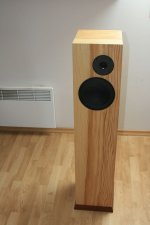 box.jpeg97.6 KB · Views: 273
box.jpeg97.6 KB · Views: 273 -
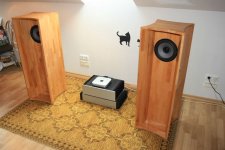 baffle.jpeg41.7 KB · Views: 270
baffle.jpeg41.7 KB · Views: 270 -
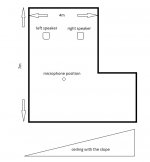 box vs baffle measurements room plan.jpg26.5 KB · Views: 271
box vs baffle measurements room plan.jpg26.5 KB · Views: 271 -
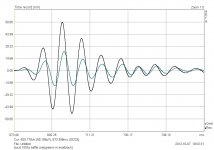 burst 100hz baffle one vs two.JPG110.8 KB · Views: 275
burst 100hz baffle one vs two.JPG110.8 KB · Views: 275 -
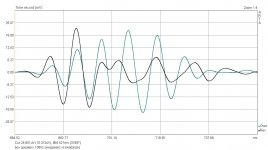 burst 100hz box one vs two.jpg123 KB · Views: 261
burst 100hz box one vs two.jpg123 KB · Views: 261 -
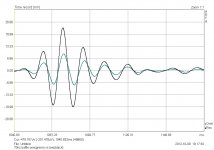 burst 70hz baffle one vs two.jpg103.3 KB · Views: 177
burst 70hz baffle one vs two.jpg103.3 KB · Views: 177 -
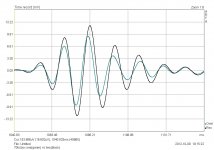 burst 70hz box one vs two.jpg112.3 KB · Views: 151
burst 70hz box one vs two.jpg112.3 KB · Views: 151 -
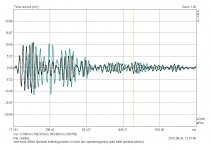 burst bafle vs box 400hz.JPG88.9 KB · Views: 173
burst bafle vs box 400hz.JPG88.9 KB · Views: 173
please can you describe your systemAgree - it is a matter of volume displacement only. I employ 6 x 12" in a stereo H-Frame tower. Very shallow wings - 3". These drivers cost me $18 each - so I discount their 8mm peak xmax spec. Probably more like 8mm peak to peak. This would put volume displacement around 2k cubic centimeters. If it were not for the need to reproduce movie bass - I'd target smaller drivers (in an array) and get some extra bandwidth.
This is a dual purposed system - high quality audio 90% of the time and the occasional movie. Not for everyone of course but they are flat to 30 Hz with EQ.
The bass is so clean and authoritative that I tend to overemphasize it and set the gain for the low channels too high.
I've been a keen advocate of dipole ESLs (nearly full range large panels) since early '70s. But.....
the advantages of the sonic strengths of dipole reproduction in homes don't apply to low bass. Nothing is gained by struggling with very large baffles (I had one) or enormous EQ boost with a sub.
While I don't believe in "matching" box types, I think the real sound quality pairing of dipoles is with a large corner horn (Klipschorn).
B.
the advantages of the sonic strengths of dipole reproduction in homes don't apply to low bass. Nothing is gained by struggling with very large baffles (I had one) or enormous EQ boost with a sub.
While I don't believe in "matching" box types, I think the real sound quality pairing of dipoles is with a large corner horn (Klipschorn).
B.
- Home
- Loudspeakers
- Multi-Way
- In Pursuit of a 20-20k Dipole Loudspeaker